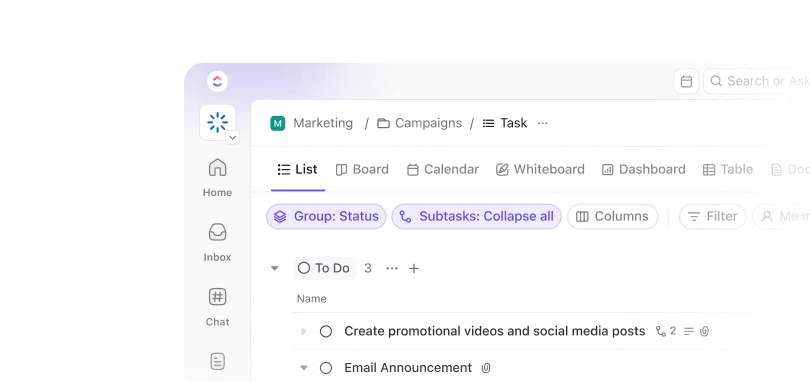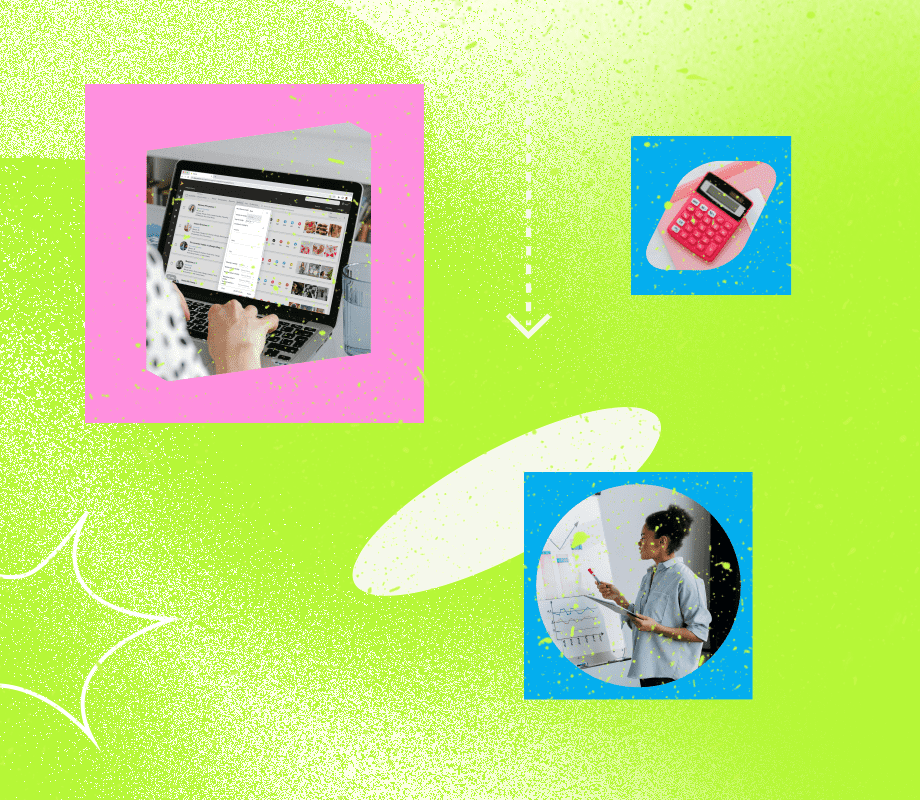It’s easy to pack a content marketing calendar with posts, emails, and ads. The harder part is proving that each asset and marketing effort contributes to business outcomes.
Organizing your calendar by campaign gives you a unified structure that ties every activity—marketing initiative, blog, social post, and email—to a larger objective.
Sales teams can instantly see which assets support pipeline growth. The product marketing team knows exactly where launch messaging lands. Leadership gains clarity on how campaigns align with quarterly goals.
In this guide, we’ll walk through how to organize a content calendar by campaign.
How to Organize Your Content Calendar by Campaign
⭐ Featured Template
Managing campaign dates, tasks, and content can quickly get overwhelming. Campaign Calendar Template makes it simple by putting everything in one clear calendar. You can instantly see what’s coming up, what’s in progress, and what’s already done.
You also get multiple views like a calendar, timeline, and task list, along with fields for campaign goals, budgets, and deadlines. It’s a simple way to keep your team on the same page and make sure every campaign runs smoothly.
How to Organize Your Content Calendar by Campaign
Why Campaign-Based Content Planning Works Better?
When you zoom out, campaign-based planning solves challenges that a post-by-post calendar can’t address, such as:
- Strategic alignment over noise: Instead of scattered posts, campaigns tie every content creation effort to a measurable business goal, turning activity into outcomes
- Clearer visibility for teams: A campaign-centered growth marketing strategy makes it easy for sales, product marketing, and leadership to see how each asset supports growth
- Stronger collaboration: Writers, designers, and marketers align their content marketing efforts toward the same campaign objective, avoiding duplication or gaps
- Better resource allocation: Campaign-level planning ensures balanced workloads across multiple channels, whether blog, email, or your social media calendar
- Easier performance tracking: Success can be measured at the campaign level—leads, conversions, awareness, not just vanity metrics from individual posts
- Scalability and consistency: Campaign structures keep your content creation process organized and reusable as your calendar expands, unlike post-by-post planning
👀 Did You Know? Studies in color psychology show that red grabs attention the fastest, which makes it useful for flagging blockers or urgent deadlines in a campaign calendar. Green signals progress, making it effective for marking completed content or approved campaigns. Using color-coding in your marketing content calendar not only adds clarity but also helps teams process information faster.
Key Elements of a Campaign-Based Content Calendar
To make campaign planning effective for every stakeholder, including marketers, designers, and leadership alike, your calendar should include these essentials:
- Campaign goals and KPIs: Include fields for objectives (e.g., product launch awareness, lead generation) and KPIs like sign-ups, conversions, or engagement rates
- Content themes and messaging: Define the central narrative or core idea for each campaign. This keeps blogs, ads, emails, and social media presence aligned under a single storyline rather than creating fragmented messaging
- Channel and format planning: Specify where each campaign asset will be published (LinkedIn, YouTube, newsletters, landing pages) and in what format (video, blog, infographic)
- Audience segments: Add notes on the target audience group for each campaign asset—whether it’s prospects in the awareness stage, existing customers, or niche buyer personas. Your editorial calendar must focus on relevant content over volume
- Timeline and milestones: Outline the campaign phases, including ideation, production, approvals, and publishing. Adding milestones keeps teams aligned on deadlines and prevents last-minute crunches
- Task ownership and collaboration: Assign clear responsibility for each asset—copywriters, designers, video editors, or campaign managers
- Accessibility and compliance checks: Build checkpoints for accessibility reviews (alt text, captions, transcripts) and compliance with brand or legal standards
- Performance tracking: Dedicate a space for tracking analytics, such as engagement, leads, or conversions. This way, you know if your content strategy is successful or failing, and what needs to be tweaked
👀 Did You Know? Nearly 1 in 4 U.S. adults lives with a disability. That means your campaigns should be designed so everyone can engage with them.
To improve accessibility, you can:
- Choose high-contrast colors for text and buttons
- Use alt text for all images
- Plan captions, transcripts, and audio descriptions for all videos in your social media content calendar
- Choose high-contrast colors for text and buttons
Steps to Organize a Content Calendar by Campaign
Here’s a clear, step-by-step guide you can follow to set up your own campaign-first content calendar.
1. Define your campaign objectives
Before filling your content calendar with posts, emails, or ads, decide what the campaign is meant to achieve.
So what’s the right way to define campaign objectives?
✅ Focus on outcomes = Generate 500 leads from Q4 webinars
❌ Focus on output = Publish four blog posts
Your objective should align with broader business priorities, such as revenue growth, product adoption, or customer retention. This makes it easier to gain buy-in from sales, product, and leadership teams.
Goals allow you to break large campaigns into measurable targets, connect them to tasks, and track progress automatically. Instead of managing goals in spreadsheets that don’t auto-update, you’ll see live updates right inside as campaign work moves forward and feeds back into broader goals.


📌 Example: Say the initiative is a quarterly feature launch. The overarching goal is “Increase demo requests by 20% in Q4.” Within that goal, break it into measurable Targets in , such as:
- Publish three thought-leadership blogs on the new product
- Launch a webinar series with 1,000 sign-ups
- Roll out an email nurture sequence with a 10% click-through rate
- Secure five industry media mentions
You can further link specific tasks or even entire projects to each Target so that progress updates automatically as work is completed.


💡 Pro Tip: If you’re stuck drafting the right objective or framing a clear campaign message, let Brain generate outcome-focused goals, messaging ideas, or even KPI suggestions in seconds. As the world’s most complete and context-aware work AI, Brain acts as your go-to assistant for everything from brainstorming to analyzing campaign results.


Hear from ’s own marketing team on how it makes our lives easier as a Contextual AI assistant.
2. Map out campaign themes and timelines
Campaign themes serve as the creative backbone of your marketing campaign. They tie together messaging, visuals, and formats to create a cohesive story across every channel for your audience.
For example, a product launch theme could center around “simplicity at scale,” shaping everything from blog headlines to ad copy.
On the other hand, timelines ensure that your great ideas actually ship on schedule. They should include content creation milestones, review stages, approvals, and launch dates.
Mapping this early prevents last-minute scrambles. It also provides every team, including writers, designers, marketers, and stakeholders, with clear visibility into when assets are due and how they fit into the broader campaign.
Whiteboards make this process more visual and collaborative. Think of it as an interactive canvas where you can:
- Brainstorm campaign themes with sticky notes, sketches, or mind maps
- Plot timelines visually by dragging and connecting tasks
- Show dependencies between assets, like how blog drafts feed into social snippets
- Involve stakeholders in real time, so feedback happens directly on the board instead of scattered across emails


By mapping themes and timelines on a Whiteboard, you move from abstract ideas to a campaign plan that everyone understands, before asset creation starts.
Once you have mapped out the campaign theme, it’s time to create a realistic timeline for all the activities within the campaign. Here’s how to do it step-by-step:
- Set the campaign duration: Decide how long the campaign will run. Is it a two-week promo, a six-week webinar push, or a quarter-long product launch?
- Break it into phases: Divide the campaign into logical parts. A simple flow looks like: Teaser phase → Launch phase → Sustain/Nurture phase → Wrap-up
- Add key milestones: Within each phase, add checkpoints that keep the campaign on track (content lock date, design handoff, QA review, go-live, etc.)
- Work backward from go-live: Start with the final deadline and plan backward. If the webinar is on May 30, your promo emails should be ready by May 20, design work by May 10, and copy finalized by May 5
- Account for dependencies: Note which tasks depend on others (ads need landing pages, creatives need approved copy). Build your timeline in such a way that one delay doesn’t break everything
- Add buffer time: Even two extra days in each phase can save the campaign if something slips
For this, you can use Gantt Charts to sketch the entire campaign timeline with dependencies (e.g., “Design assets” must be completed before “Publishing landing page”).


If you’d rather not start from scratch, ’s Campaign Calendar Template gives you a ready-to-use structure to map campaigns directly into a calendar view.
Unlike Whiteboards (for brainstorming) or Gantt Charts (for sequencing tasks), the Campaign Calendar Template is designed to:
- Show you all campaigns at a glance on a shared timeline
- Map assets like blogs, emails, or ads to the exact day they’ll publish
- Highlight overlaps between campaigns so you can balance workloads
- Provide a consistent format that keeps marketing, product, and leadership aligned
Most organizations use it as an operational calendar, where every campaign is listed, along with deadlines. This way, you don’t lose track of the big picture, regardless of the number of campaigns going on.
📊 Pro Tip: Planning what to publish is only half the job. Knowing when to post is just as important. Data from Hootsuite Q1 2025 shows the best posting times across multiple platforms:
- Facebook: Tuesdays at 9 AM
- X (Twitter): 9–11 AM on Wed, Thu, Fri
- LinkedIn: 4–6 AM on Tue & Wed
- TikTok: Thursdays from 7–11 AM
- Threads: Tuesdays at 8 AM
- Pinterest: Fridays at 12 PM
- Instagram: Mondays from 3–9 PM
Keep this in mind while scheduling your campaign’s social media calendar. Aligning with these windows can give your content a better shot at engagement.
3. Break campaigns into assets and formats
Your campaign will need a mix of content assets: blog posts, videos, social media posts, email sequences, landing pages, and more. Breaking them down early prevents two common problems:
- Teams realize too late that a key asset is missing
- Spending too much time creating low-value pieces
To do so, you must:
List required assets
Based on your campaign theme and messaging pillars, identify what assets you’ll need at each funnel stage. For instance, awareness might require blogs and social ads, while conversion may rely on case studies and product demos.
Map formats to channels
A single idea can take multiple forms across channels. A webinar can be repurposed into blog highlights, social clips, or an email series.
Prioritize by impact
Not every asset moves the needle equally. For example, an in-depth case study may generate more late-stage conversions than five short blog posts.
Similarly, if pipeline growth is the goal, doubling down on a strong email marketing strategy—with well-timed nurture sequences and product-focused emails may drive higher ROI than producing extra social posts.
💡 Pro Tip: Here are the most widely used content channels that other B2B marketers are investing in:
- Organic social: 89%
- Website/blog: 87%
- In-person events: 64%
- Newsletters: 63%
- Video: 57%
When breaking campaigns into assets, start with a clear brief. ’s Campaign Brief Template makes this easier by giving you a ready-to-use structure for documenting campaign objectives, required assets, and channel mapping.
🎺 Advantage: You could try piecing together campaign plans with slides, spreadsheets, and endless email threads. But this kind of Work Sprawl leads to silos, version chaos, and missed deadlines.
That’s where ’s Marketing Campaign Management Software comes in. It brings your goals, briefs, timelines, assets, and performance tracking into one Converged AI Workspace, so your team always knows what’s next and how campaigns are performing.


4. Assign ownership and responsibilities
A campaign falls apart when everyone knows the goal, but nobody knows their part. You may want to consider breaking deliverables into smaller tasks, assigning an owner to each task, and adding realistic deadlines.
Here’s a simple flow to follow:
- Assign primary and supporting roles: Every task should have one owner responsible for its completion. Supporting contributors (like a designer for visuals or a copy editor for reviews) can be assigned as collaborators, but final accountability must sit with one person
- Define dependencies: Some assets can’t move forward until another is finished. For example, a social promo graphic depends on the approved blog headline. By mapping these dependencies beforehand, you can make sure that your team members know when to start and when to wait
- Balance workloads: Campaigns can get derailed if one person is overloaded while others are underutilized. A balanced assignment process ensures the right capacity across the team
makes these practices easier with the ability to add Multiple Assignees and by letting you hold each of them responsible for the completion of a task. Plus, with Task Dependencies, you can set relationships between tasks (e.g., “Task B can’t start until Task A is finished.”) to manage the workflow order better.


To avoid wasting time assigning tasks manually, you can also set up Automations to auto-assign a task. For example, when a task’s status changes to “Copy Approved,” the next task in line, “Design,” is automatically assigned to the designer (who receives an automated notification when this happens).


You can manage this within the Marketing Campaign Management Template. You can create tasks for each deliverable, which can be bunched as lists. You can add the respective team or person for each task. For example, the social media manager will know that the behind-the-scenes content video is ready for posting by the video production team. This template centralizes everything in your marketing campaign management process.
This list template includes:
- Five Custom Statuses to keep track of the progress of each campaign
- Eleven custom attributes to save vital information about the campaign
- Seven custom views to organize your campaign information
To go a step further, ’s Marketing Campaign Plan Template gives you a bird’s-eye view of entire campaigns, not just individual tasks. While task assignments ensure ownership, this template helps you connect owners, assets, approvals, and timelines into a single campaign roadmap.
Think of it as the playbook that makes sure all the moving parts of your campaign work together seamlessly, from strategy to execution.
📮 Insight: 1 in 4 employees uses four or more tools just to build context at work. A key detail might be buried in an email, expanded in a Slack thread, and documented in a separate tool, forcing teams to waste time hunting for information instead of getting work done.
converges your entire workflow into one unified platform. With features like Email Project Management, Chat, Docs, and Brain, everything stays connected, synced, and instantly accessible. Say goodbye to “work about work” and reclaim your productive time.
💫 Real Results: Teams are able to reclaim 5+ hours every week using —that’s over 250 hours annually per person—by eliminating outdated knowledge management processes. Imagine what your team could create with an extra week of productivity every quarter!
⚡ Template Archive: Once tasks, owners, and deadlines are set, marketing campaign templates give you a ready framework to connect goals, assets, approvals, and timelines in one place.
5. Build in accessibility and approval workflows
Why should you include accessibility and approval workflows in your campaign review process?
Because they help you avoid the common pitfalls, such as:
- Vague reviewer roles (everyone comments, no one signs off)
- Scattered feedback (email/DMs/drive notes = lost context)
- “Last-minute” accessibility fixes (alt text, captions, contrast) that derail timelines
So what’s the solution?
Map out review stages (content, brand/legal, accessibility) and assign a single owner for sign-off at each step. Use a simple checklist: accuracy, voice, alt text, captions, and SEO basics to keep feedback structured and actionable.
You can use Proofing to leave contextual feedback and comments right on creative assets, whether it’s a blog draft, a video thumbnail, or a social media graphic. This keeps feedback tied to the exact spot that needs changes.


To make review discussions easy to track, capture them in a Doc. That way, instead of feedback being buried in long email threads or Slack pings, your team has a single space where revisions, approvals, and final notes live, serving as a source of truth for future projects as well.
Use ’s Campaign & Promotion Management Template to streamline the approval cycle. Within this template, you can track the status of each campaign, categorize different campaigns, add the marketing channels activity-wise, and also mention the marketing goal for each activity.
It also gives:
- Dedicated space to track promotional marketing activities alongside campaign tasks
- Clear statuses for approvals to see if something is stuck in Review or Ready to Publish
- Built-in dependency tracking to keep handoffs between teams smooth
- Centralized view of all promos (social, ads, partnerships) to align them with the main campaign timeline
⚡ Template Archive: Promotions often involve managing multiple ads, assets, and approval cycles across different channels. Instead of building every promo plan from scratch, use these advertising templates to save time and stay consistent.
6. Track performance alongside execution
The best campaigns don’t end when the last asset goes live. The real value lies in reflecting on how the campaign performed and using those insights to make the next one even sharper.
Here’s how to do it in practice:
- Look at the marketing goals you set in your campaign brief (signups, clicks, demos booked) and see how close you got. Did you hit the targets, exceed them, or fall short?
- Break down results by top-performing content (channel and format). Did email outperform social? Did video ads bring better leads than static images?
- When you run a similar campaign again, duplicate your calendar, adjust based on learnings, and run a tighter marketing playbook
- Don’t just store results in a doc. Share a quick summary with the team and leadership. It closes the loop and reinforces why campaign-based planning works.
With Dashboards, you can centralize all your campaign performance data for everyone to see the campaign’s health. You can build cards for traffic, leads, engagement rates, or conversion progress, and pull updates directly from linked tasks and Goals.


But visibility is only half the story. You also need to capture what those numbers mean. That’s where the AI Notetaker comes in. During campaign review meetings, let the AI Note Taker record the discussion: what worked, what underperformed, and what needs to change.


This video shows you how to automate meeting notes and tasks using ’s Notetaker and Calendar.
📌 Insight: PMI’s 2025 Pulse Report found that the three classic constraints, including scope, schedule, and cost, still shape project success. Among them, schedule pressure is the top challenge teams need to manage.
Building realistic timelines (with buffer time) makes all the difference between campaigns that land smoothly and ones that fall apart.
Add AI to the Mix for Smarter Campaign Planning
Campaign planning today moves faster than ever with more channels, more assets, and more data to handle. Amid this need to do more with fewer resources, you need AI as your strategic planning tool. Here are some practical ways to use AI in digital marketing for every stage of campaign planning.
1. Creating campaign briefs
Campaign briefs, messaging guides, or creative outlines often get delayed because someone has to sit down and write them. With Brain, you can instantly generate campaign documentation.


It helps you:
- Draft objectives, key messages, and creative briefs
- Rewrite or refine content for clarity and consistency
- Summarize long research notes into digestible points for stakeholders
This video will help you know more about how to use Brain to write documentation.
2. Agents to automate campaign workflows
Agents act like smart assistants inside your workspace. Instead of manually setting reminders, updating tasks, or sending follow-ups, you can assign agents to do it for you.
For campaign planning, agents can:
- Notify stakeholders when an asset is ready for review, and even perform an autonomous preliminary review against a checklist (or brand guidelines)
- Auto-assign dynamic tasks based on logic and assessment when a campaign status changes
- Trigger and draft email or Slack updates when milestones are hit
Here’s how you can build an AI Agent to automate tasks for you in .
3. Brain MAX to reduce Work Sprawl
Most marketing teams struggle with too many tools: one for documentation, another for project tracking, another for content briefs. Brain MAX brings advanced AI features and combines access to multiple AI models directly into a Super App for your desktop, so you don’t have to toggle between disconnected platforms.
- Replace external AI writing tools with Brain for campaign copy and messaging
- Use ’s Enterprise AI Search across all campaign docs, briefs, and tasks in one place
- Centralize brainstorming, drafting, and execution in a single hub
This video provides additional reasons to try Brain MAX as a standalone app.
4. AI knowledge retrieval for campaign context
Brain also works as an AI knowledge base for your workspace. Instead of asking a colleague, “Where’s that Q3 campaign brief?” and distracting them, you can simply ask Brain inside , and it will pull relevant information from your Workspace.
This makes it easy for new team members, freelancers, or stakeholders to get context fast. No more digging through emails or conversation threads to find the right information.


5. Generate images and visuals
If you don’t want to rely on designers for every graphic or your design team is busy, Brain also helps you with AI-powered image generation.
Create draft visuals, ad mockups, or concept graphics directly in your workspace. AI-generated images can give your team a fast starting point, whether you need a quick blog header, a social media graphic, or a campaign theme illustration.


Organize Smarter Content Campaigns with
Ready to organize your content calendar by campaign?
centralizes your campaign planning, assets, feedback discussions, and even monitoring into one app. With its suite of features, templates, and Contextual AI, content calendars become a little less overwhelming and a lot more effective.
To get started, sign up on for free.


Everything you need to stay organized and get work done.
















